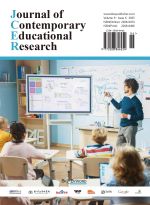Abstract
Hybrid teaching has become an essential direction of the teaching reform and innovation of higher education, and puts forward new requirements for the evaluation system of teaching quality. The background of hybrid teaching, the CIPP model, and teaching quality evaluation system, and the necessity of constructing a hybrid teaching quality evaluation system are further discussed. This paper also discusses the evaluation focus of the CIPP model and its applicability in the hybrid teaching quality evaluation and believes that the CIPP model can reflect the concept innovation, target diversity, process advancement, and subject participation; the evaluation indicator system of hybrid teaching quality is designed based on the CIPP model, which provides a reference for the hybrid teaching quality evaluation and teaching reform.
References
Zhou Q, Jiang L, Liu Z, 2024, Research on College Students’ Learning Investment and Learning Satisfaction Under the Background of New Normal of Mixed Teaching. Science, Education, and Literature, 18: 180–183.
Verawat D, 2019, Solusi Pembelajaran 4.0: Hybrid Learning. Seminar Nasional Pendidikan, 1183–1192.
Margaret D, 2002, On Certain Integrals of Lipschitz-Hankel Type Involving Products of Bessel Functions. E-Learning and Digital Media, 3: 999–1015.
Hidayah SN, 2019, Hybrid Model-based Learning in Welcome Era Industrial Revolution 4.0. The Innovation of Social Studies Journal, 1: 46–54. https://doi.org/10.20527/iis.v1i1.1262
Chan YF, Narasuman S, Dalim SF, et al., 2016, Blended Learning as A Conduit for Inquiry-based Instruction, Active Learning, Formative Assessment, and Its Impact on Students’ Learning Outcomes in Higher Education, 74–78.
Klimova BF, Kacetl J, 2015, Hybrid Learning and Its Current Role in the Teaching of Foreign Languages. Procedia - Social and Behavioral Sciences, 182: 477–481. https://doi.org/10.1016/j.sbspro.2015.04.830
Syafril S, Latifah S, Engkizar E, et al., 2021, Hybrid Learning on Problem-solving Abilities in Physics Learning: A Literature Review. Journal of Physics: Conference Series, 1796: 012–021. https://doi.org/10.1088/1742-6596/1796/1/012021
Mathison S, 2004, Encyclopedia of Evaluation, Sage Publications, London.
Zhong J, 2024, Construction of Teaching Quality Evaluation System Based on CIPP Model. Chinese Journal of Multimedia and Network Teaching, 6: 120–123.
Singh MD, 2024, Evaluation Framework for Nursing Education Programs: Application of the CIPP Model. International Journal of Nursing Education Scholarship, 1: 120–123. https://doi.org/10.2202/1548-923X.1023
Yi S, 2022, Digital Thinking: An Innovative Framework in the Process of Fashion Sustainability. Art and Design Research, 2: 17–22.
Yan J, An J, Sun G, 2023, Reconstruction of Classroom Teaching Quality Evaluation Index System. China University Teaching, 12: 74–78, 91.
Feistauer D, Richter T, 2016, How Reliable are Students’ Evaluations of Teaching Quality? A Variance Components Approach. Assessment & Evaluation in Higher Education, 8: 1263–1279. https://doi.org/10.1080/02602938.2016.1261083
Goos M, Salomons A, 2017, Measuring Teaching Quality in Higher Education: Assessing Selection Bias in Course Evaluations. Research in Higher Education, 8: 341–364. https://doi.org/10.1007/s11162-016-9429-8
Denzin NK, Lincoln YS, 1996, Handbook of Qualitative Research. Journal of Leisure Research, 2: 132.
